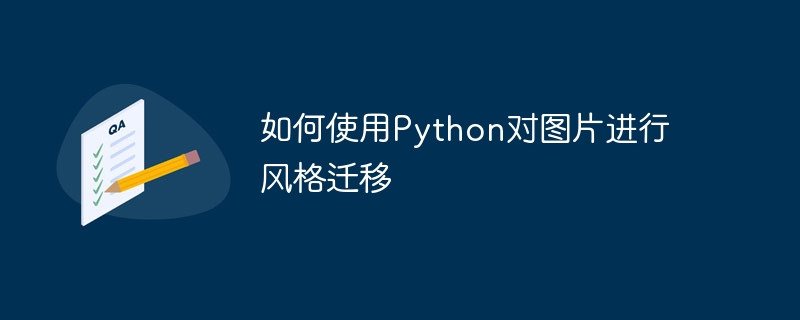Python を使用して画像のスタイル転送を実行する方法

Python を使用して画像のスタイル転送を実行する方法
はじめに:
スタイル転送は、コンピューター ビジョンの分野における興味深い、やりがいのあるタスクです。 1 つの写真の内容を別の写真のスタイルと組み合わせて独特の芸術的効果を生み出し、画像処理、デザイン、エンターテイメントなどの分野で広く使用されています。この記事では、Python プログラミング言語を深層学習アルゴリズムと組み合わせて使用し、画像のスタイル転送を実現する方法を紹介します。
ステップ 1: 必要なライブラリをインポートする
まず、TensorFlow、Keras、NumPy、Matplotlib などの必要な Python ライブラリをインポートする必要があります。次のコードを実行します。
import tensorflow as tf from tensorflow import keras import numpy as np import matplotlib.pyplot as plt
ステップ 2: 事前トレーニングされたモデルをロードする
スタイル転送では、VGG19 などの事前トレーニングされた畳み込みニューラル ネットワーク モデルを使用できます。このモデルは画像認識タスクで優れたパフォーマンスを発揮し、スタイル転送タスクでも広く使用されています。次のコードを実行します。
vgg = tf.keras.applications.VGG19(include_top=False, weights='imagenet') vgg.trainable = False
ステップ 3: コンテンツ損失を定義する
コンテンツ損失は、2 つの画像間のコンテンツの違いを測定するために使用されます。 VGG モデルの中間層を使用して、画像のコンテンツ特徴を抽出できます。具体的には、VGG モデルの特定の畳み込み層をコンテンツ層として選択し、これらの層上の入力画像とターゲット画像の特徴表現を比較できます。次のコードを実行します。
content_layers = ['block5_conv2'] content_extractor = keras.Model(inputs=vgg.input, outputs=[vgg.get_layer(name).output for name in content_layers])
ステップ 4: スタイル損失を定義する
スタイル損失は、2 つの画像間のスタイルの違いを測定するために使用されます。グラム行列を使用して画像内の異なるチャネル間の相関を表し、テクスチャや色などの観点から画像の特性を測定できます。次のコードを実行します。
style_layers = ['block1_conv1', 'block2_conv1', 'block3_conv1', 'block4_conv1', 'block5_conv1']
style_extractor = keras.Model(inputs=vgg.input, outputs=[vgg.get_layer(name).output for name in style_layers])
def gram_matrix(input_tensor):
channels = int(input_tensor.shape[-1])
a = tf.reshape(input_tensor, [-1, channels])
n = tf.shape(a)[0]
gram = tf.matmul(a, a, transpose_a=True)
return gram / tf.cast(n, tf.float32)ステップ 5: 合計変動損失を定義する
合計変動損失は、合成画像を滑らかに保つために使用されます。合成画像の各ピクセルとその隣接ピクセルの差を合計することにより、ノイズと不連続なエッジを減らすことができます。次のコードを実行します。
def total_variation_loss(image):
x = tf.image.image_gradients(image)
return tf.reduce_sum(tf.abs(x[0])) + tf.reduce_sum(tf.abs(x[1]))ステップ 6: 目的関数を定義する
コンテンツ損失、スタイル損失、および合計バリエーション損失を組み合わせて、包括的な目的関数を形成します。目的関数は、画像の内容とスタイルの間の差異を最小限に抑え、制約を満たす合成画像を生成するために使用されます。次のコードを実行します。
def compute_loss(image, content_features, style_features):
content_output = content_extractor(image)
style_output = style_extractor(image)
content_loss = tf.reduce_mean(tf.square(content_output - content_features))
style_loss = tf.add_n([tf.reduce_mean(tf.square(style_output[i] - style_features[i])) for i in range(len(style_output))])
content_loss *= content_weight
style_loss *= style_weight
tv_loss = total_variation_loss(image) * total_variation_weight
loss = content_loss + style_loss + tv_loss
return loss
@tf.function()
def train_step(image, content_features, style_features, optimizer):
with tf.GradientTape() as tape:
loss = compute_loss(image, content_features, style_features)
gradients = tape.gradient(loss, image)
optimizer.apply_gradients([(gradients, image)])
image.assign(tf.clip_by_value(image, 0.0, 1.0))ステップ 7: スタイル転送の実行
モデルの定義が完了したら、カスタム トレーニング関数を使用して合成画像を繰り返し最適化し、内容と一貫性が保たれるようにします。対象となる画像は可能な限り類似しています。次のコードを実行します。
def style_transfer(content_path, style_path, num_iteration=1000, content_weight=1e3, style_weight=1e-2, total_variation_weight=30):
content_image = load_image(content_path)
style_image = load_image(style_path)
content_features = content_extractor(content_image)
style_features = style_extractor(style_image)
opt = keras.optimizers.Adam(learning_rate=0.02, beta_1=0.99, epsilon=1e-1)
image = tf.Variable(content_image)
start_time = time.time()
for i in range(num_iteration):
train_step(image, content_features, style_features, opt)
if i % 100 == 0:
elapsed_time = time.time() - start_time
print('Iteration: %d, Time: %.2fs' % (i, elapsed_time))
plt.imshow(image.read_value()[0])
plt.axis('off')
plt.show()
image = image.read_value()[0]
return imageステップ 8: スタイルの移行を実行する
最後に、コンテンツ イメージとスタイル イメージを選択し、style_transfer() 関数を呼び出してスタイルを実行します。移住。次のコードを実行します:
content_path = 'content.jpg'
style_path = 'style.jpg'
output_image = style_transfer(content_path, style_path)
plt.imshow(output_image)
plt.axis('off')
plt.show()結論:
この記事では、Python プログラミング言語を深層学習アルゴリズムと組み合わせて使用して、画像のスタイル転送を実現する方法を紹介します。コンテンツロス、スタイルロス、トータルバリエーションロスを定義した事前トレーニング済みモデルを読み込み、カスタムトレーニング関数と組み合わせることで、コンテンツ画像とスタイル画像をそれぞれの特徴を組み合わせた新しい画像に合成できます。継続的に反復的な最適化を行うことで、与えられた制約を満たす最終的な合成画像を取得できます。この記事の紹介を通じて、読者がスタイル転送の基本原理と実装方法を理解し、画像処理や芸術的創作などの分野でこのテクノロジーの可能性をさらに探求し、応用できることを願っています。
以上がPython を使用して画像のスタイル転送を実行する方法の詳細内容です。詳細については、PHP 中国語 Web サイトの他の関連記事を参照してください。

ホットAIツール

Undresser.AI Undress
リアルなヌード写真を作成する AI 搭載アプリ

AI Clothes Remover
写真から衣服を削除するオンライン AI ツール。

Undress AI Tool
脱衣画像を無料で

Clothoff.io
AI衣類リムーバー

Video Face Swap
完全無料の AI 顔交換ツールを使用して、あらゆるビデオの顔を簡単に交換できます。

人気の記事

ホットツール

メモ帳++7.3.1
使いやすく無料のコードエディター

SublimeText3 中国語版
中国語版、とても使いやすい

ゼンドスタジオ 13.0.1
強力な PHP 統合開発環境

ドリームウィーバー CS6
ビジュアル Web 開発ツール

SublimeText3 Mac版
神レベルのコード編集ソフト(SublimeText3)

ホットトピック
 7675
7675
 15
15
 1393
1393
 52
52
 1207
1207
 24
24
 91
91
 11
11
 PHPおよびPython:さまざまなパラダイムが説明されています
Apr 18, 2025 am 12:26 AM
PHPおよびPython:さまざまなパラダイムが説明されています
Apr 18, 2025 am 12:26 AM
PHPは主に手順プログラミングですが、オブジェクト指向プログラミング(OOP)もサポートしています。 Pythonは、OOP、機能、手続き上のプログラミングなど、さまざまなパラダイムをサポートしています。 PHPはWeb開発に適しており、Pythonはデータ分析や機械学習などのさまざまなアプリケーションに適しています。
 PHPとPythonの選択:ガイド
Apr 18, 2025 am 12:24 AM
PHPとPythonの選択:ガイド
Apr 18, 2025 am 12:24 AM
PHPはWeb開発と迅速なプロトタイピングに適しており、Pythonはデータサイエンスと機械学習に適しています。 1.PHPは、単純な構文と迅速な開発に適した動的なWeb開発に使用されます。 2。Pythonには簡潔な構文があり、複数のフィールドに適しており、強力なライブラリエコシステムがあります。
 Visual StudioコードはPythonで使用できますか
Apr 15, 2025 pm 08:18 PM
Visual StudioコードはPythonで使用できますか
Apr 15, 2025 pm 08:18 PM
VSコードはPythonの書き込みに使用でき、Pythonアプリケーションを開発するための理想的なツールになる多くの機能を提供できます。ユーザーは以下を可能にします。Python拡張機能をインストールして、コードの完了、構文の強調表示、デバッグなどの関数を取得できます。デバッガーを使用して、コードを段階的に追跡し、エラーを見つけて修正します。バージョンコントロールのためにGitを統合します。コードフォーマットツールを使用して、コードの一貫性を維持します。糸くずツールを使用して、事前に潜在的な問題を発見します。
 VSCODE拡張機能は悪意がありますか?
Apr 15, 2025 pm 07:57 PM
VSCODE拡張機能は悪意がありますか?
Apr 15, 2025 pm 07:57 PM
VSコード拡張機能は、悪意のあるコードの隠れ、脆弱性の活用、合法的な拡張機能としての自慰行為など、悪意のあるリスクを引き起こします。悪意のある拡張機能を識別する方法には、パブリッシャーのチェック、コメントの読み取り、コードのチェック、およびインストールに注意してください。セキュリティ対策には、セキュリティ認識、良好な習慣、定期的な更新、ウイルス対策ソフトウェアも含まれます。
 Windows 8でコードを実行できます
Apr 15, 2025 pm 07:24 PM
Windows 8でコードを実行できます
Apr 15, 2025 pm 07:24 PM
VSコードはWindows 8で実行できますが、エクスペリエンスは大きくない場合があります。まず、システムが最新のパッチに更新されていることを確認してから、システムアーキテクチャに一致するVSコードインストールパッケージをダウンロードして、プロンプトとしてインストールします。インストール後、一部の拡張機能はWindows 8と互換性があり、代替拡張機能を探すか、仮想マシンで新しいWindowsシステムを使用する必要があることに注意してください。必要な拡張機能をインストールして、適切に動作するかどうかを確認します。 Windows 8ではVSコードは実行可能ですが、開発エクスペリエンスとセキュリティを向上させるために、新しいWindowsシステムにアップグレードすることをお勧めします。
 Python vs. JavaScript:学習曲線と使いやすさ
Apr 16, 2025 am 12:12 AM
Python vs. JavaScript:学習曲線と使いやすさ
Apr 16, 2025 am 12:12 AM
Pythonは、スムーズな学習曲線と簡潔な構文を備えた初心者により適しています。 JavaScriptは、急な学習曲線と柔軟な構文を備えたフロントエンド開発に適しています。 1。Python構文は直感的で、データサイエンスやバックエンド開発に適しています。 2。JavaScriptは柔軟で、フロントエンドおよびサーバー側のプログラミングで広く使用されています。
 PHPとPython:彼らの歴史を深く掘り下げます
Apr 18, 2025 am 12:25 AM
PHPとPython:彼らの歴史を深く掘り下げます
Apr 18, 2025 am 12:25 AM
PHPは1994年に発信され、Rasmuslerdorfによって開発されました。もともとはウェブサイトの訪問者を追跡するために使用され、サーバー側のスクリプト言語に徐々に進化し、Web開発で広く使用されていました。 Pythonは、1980年代後半にGuidovan Rossumによって開発され、1991年に最初にリリースされました。コードの読みやすさとシンプルさを強調し、科学的コンピューティング、データ分析、その他の分野に適しています。
 ターミナルVSCODEでプログラムを実行する方法
Apr 15, 2025 pm 06:42 PM
ターミナルVSCODEでプログラムを実行する方法
Apr 15, 2025 pm 06:42 PM
VSコードでは、次の手順を通じて端末でプログラムを実行できます。コードを準備し、統合端子を開き、コードディレクトリが端末作業ディレクトリと一致していることを確認します。プログラミング言語(pythonのpython your_file_name.pyなど)に従って実行コマンドを選択して、それが正常に実行されるかどうかを確認し、エラーを解決します。デバッガーを使用して、デバッグ効率を向上させます。




